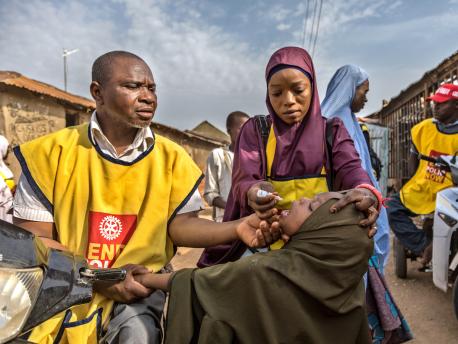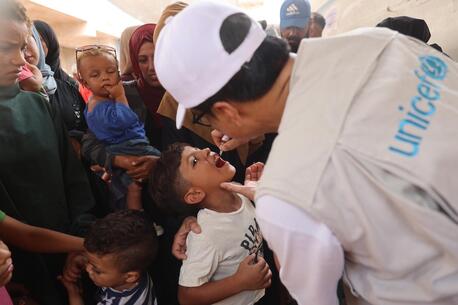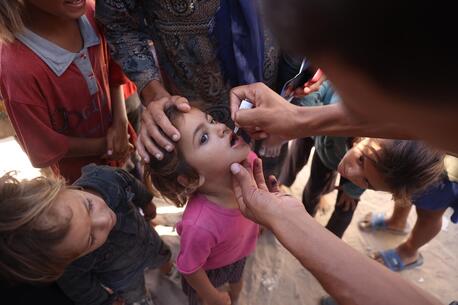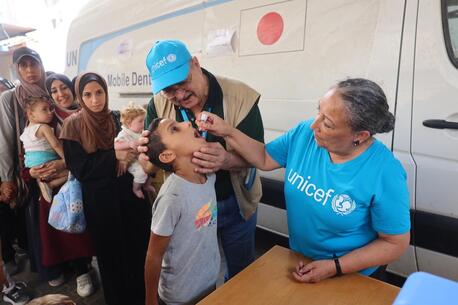
Vaccinating the World Against a Virus: What It Will Take
We have been here before: Lessons learned in the fight against polio are informing the global COVID-19 response.
We are living through a pivotal moment in history. With COVID-19 vaccine procurement and delivery underway, we are in the midst of a global health initiative unlike what many of us have seen. But in some ways, we have been here before – with polio.
In the early part of the 20th century, few diseases affected children and communities more than polio. At its peak, the disease devastated over 350,000 lives every year, disproportionately affecting children under the age of 5. By the early 1950s, widespread polio outbreaks in countries around the world led to shutdowns of schools, parks and pools — much like what the world has experienced in this past year during the coronavirus pandemic.
30 years after the licensing of a polio vaccine, the disease had disappeared in the U.S., Australia and much of Europe — but remained prevalent in more than 125 countries
So, how did the world address one of the biggest public health challenges of its time? While polio is not curable, there is an effective vaccine to prevent it. Immediately following licensing of a vaccine in 1955, a mass vaccination campaign was launched and by 1988, polio had disappeared from the U.S., Australia and much of Europe. But at that time polio remained prevalent in more than 125 countries.
Rotary International, UNICEF and our partners in the Global Polio Eradication Initiative (GPEI) — which now include the World Health Organization (WHO), the US Centers for Disease Control and Prevention (CDC), the Bill & Melinda Gates Foundation and Gavi, the Vaccine Alliance — undertook the ambitious goal to rid the world of polio. The outcome has been extraordinary: polio has been reduced by 99 percent, and nearly 19 million people who may otherwise have been paralyzed are walking as a result of vaccination. Just two countries continue to report cases of wild polio: Afghanistan and Pakistan.
Vaccines have proven to be one of the greatest advances of modern medicine
So why are we talking about polio vaccines now? Because vaccines have proven to be one of the greatest advances of modern medicine. The WHO estimates that vaccines save between 2 to 3 million lives each year. Specifically, the equitable distribution of the oral polio vaccine (OPV) to vulnerable children across the globe — including those in hard-to-reach areas and regions rife with conflict — has been critical to the progress made in the fight to eradicate polio. It's this example we should look to as we continue our COVID-19 immunization efforts.
“We have it in our own hands to achieve success in stopping the coronavirus, just as we do with polio,” said Rotary International President Holger Knaack. “There are no technical or biological reasons why polio or COVID-19 should persist anywhere in the world. It is now a question of political and societal will.”
As we seek to ensure that everyone receives a coronavirus immunization, we are also mindful that once more doses of COVID-19 vaccines are available and delivery is scaled up, it will stretch the capacity of existing childhood immunization programs. “We must adequately plan for the implementation of COVID-19 vaccine delivery needs in parallel with other immunizations and other essential services, not at their cost,” said UNICEF Executive Director Henrietta Fore.
To end the pandemic, COVID-19 vaccination efforts must reach all countries now
While the development and distribution of COVID-19 vaccines have brought hope, promise and the vision of a return to normalcy in some parts of the world, many parts of the world continue to suffer outbreaks that are driving daily worldwide infections to their highest levels yet. India's COVID-19 case rate topped 400,000 a day at its peak in mid-May, creating a critical oxygen shortage, a lack of hospital beds and a mounting death toll. We must ensure that countries like India and Brazil are supported through this crisis and that communities receive fair and equitable access to vaccines by revisiting the playbook we used to eliminate wild polio in all but two countries.
Ultimately, there is a role for everyone to play to curb the pandemic: stepping up to be vaccinated as soon as doses become available, stopping the spread of vaccine misinformation in our communities and educating those around us on the safety and efficacy of vaccines. And collectively, organizations like Rotary and UNICEF and our other partners in the GPEI must continue to leverage our polio partnership to work together to strengthen health and immunization systems around the world because we recognize that the pandemic will not be over for anyone until it is over for everyone.
Top photo: Health workers and volunteers participate in a polio immunization campaign in Kaduna, Nigeria in 2019. © Rotary International
HOW TO HELP
There are many ways to make a difference
War, famine, poverty, natural disasters — threats to the world's children keep coming. But UNICEF won't stop working to keep children healthy and safe.
UNICEF works in over 190 countries and territories — more places than any other children's organization. UNICEF has the world's largest humanitarian warehouse and, when disaster strikes, can get supplies almost anywhere within 72 hours. Constantly innovating, always advocating for a better world for children, UNICEF works to ensure that every child can grow up healthy, educated, protected and respected.
Would you like to help give all children the opportunity to reach their full potential? There are many ways to get involved.





